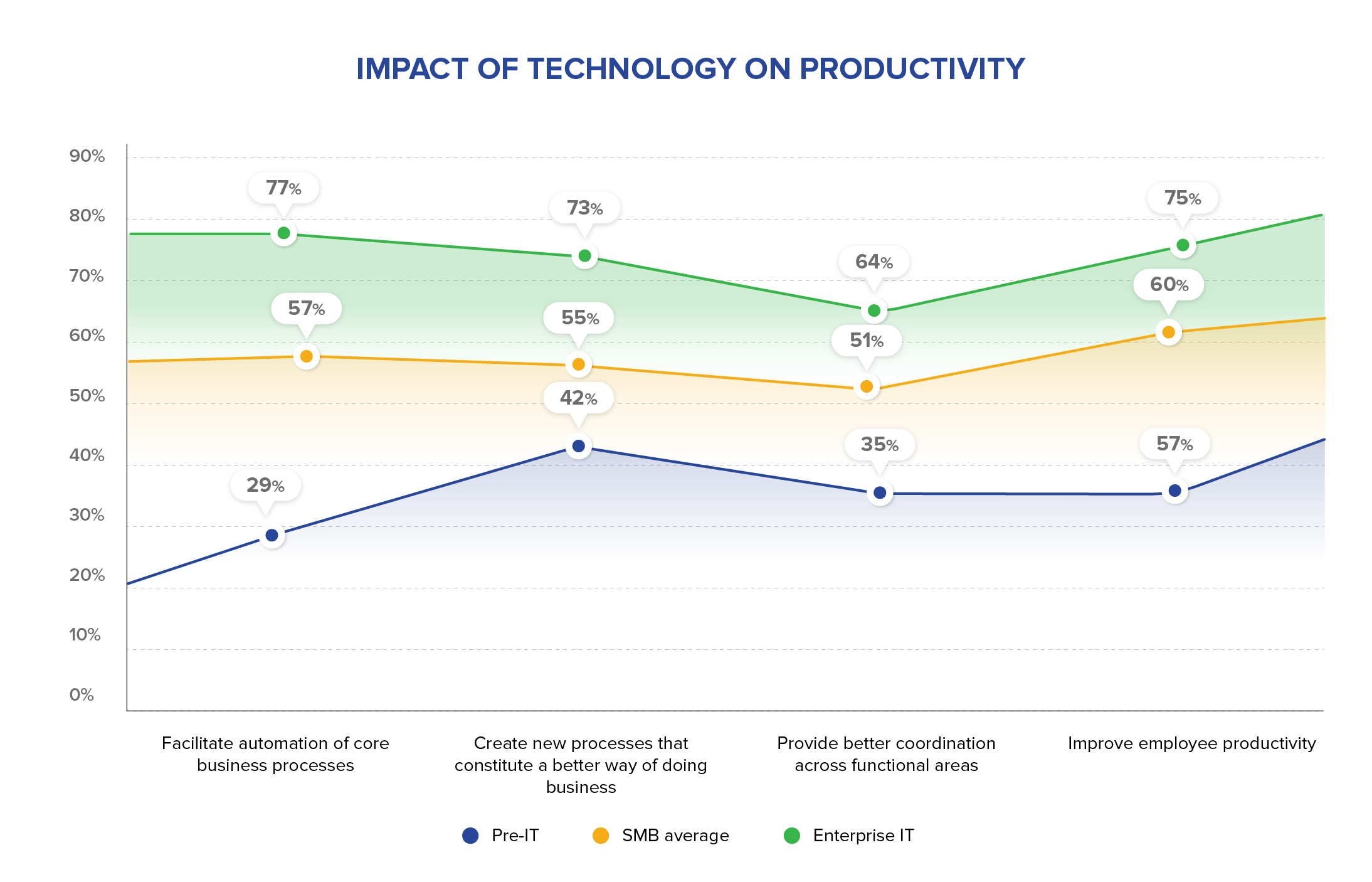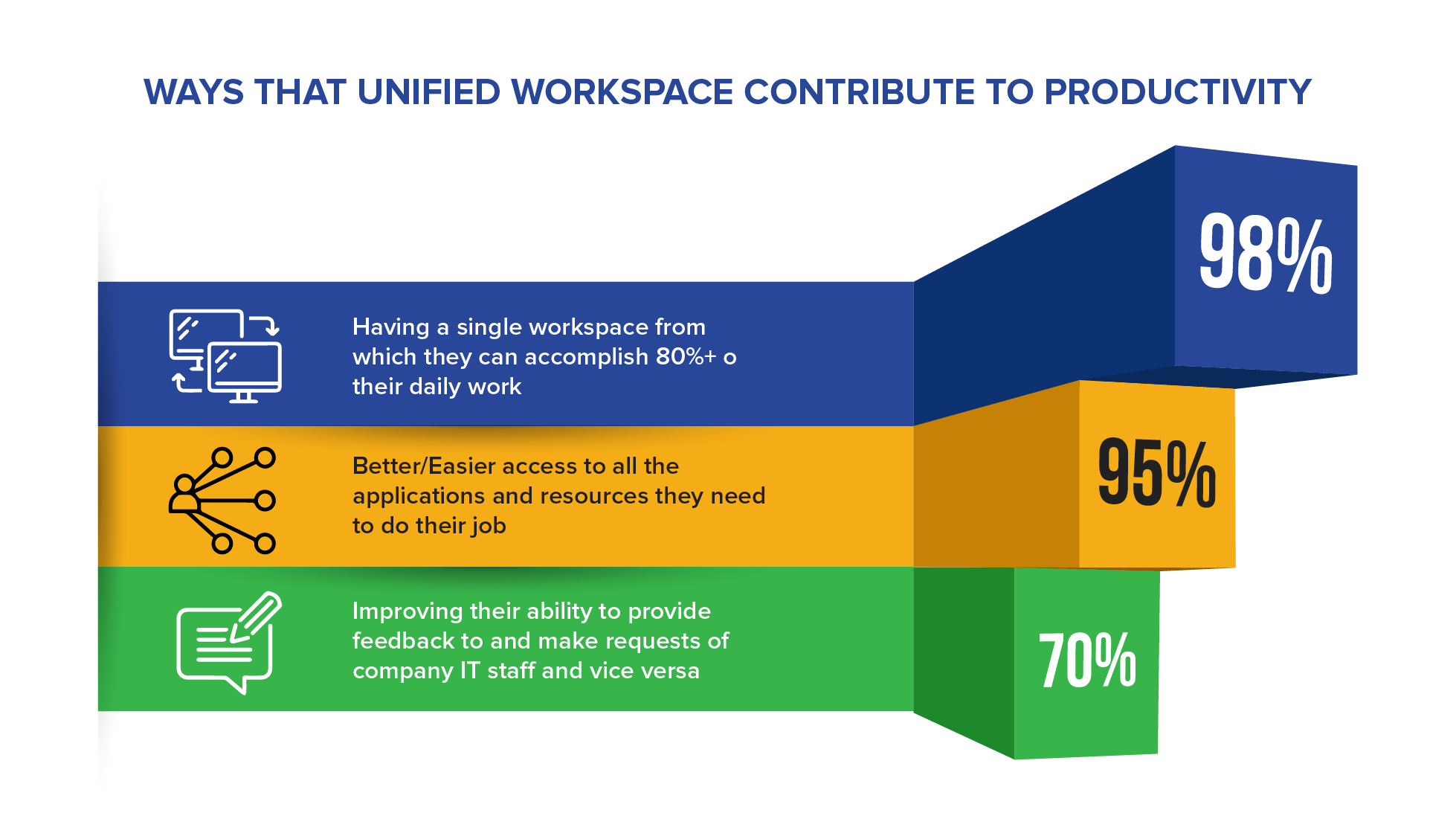Techaisle global research shows that 409 million SMB employees will still be in hybrid work mode at the end of 2021. As a result, SMBs are investing in processes, products, and policies to support hybrid workforces. Better hardware equipment and mobile devices are an essential component of remote work, but remote work enablement extends beyond hardware to applications, solutions, and work habits. Techaisle data also found that improving workforce productivity is among the top five business objectives for SMB and midmarket segments. Many factors drive productivity, including management approaches, processes and practices, and collaboration/synergy across activities and functions. But technology is a pivotal contributor to productivity directly and through its ability to affect operations and internal coordination positively. Moreover, as the chart below demonstrates, these benefits don't accrue to all SMBs equally. SMBs that are advanced in their approach to IT ("Enterprise IT") are about twice as likely to achieve the productivity-enabled benefits than lowest-performing firms and 30% more likely to realize productivity benefits than the average SMB. IT provides the tools to support greater employee efficiency and productivity. So what are the best ways to help the workforce to capture these benefits and be more productive?

The above data shows that technology is seen as a source of productivity-enhancing capabilities – meaning, in some way, IT has 'permission' from the business to help drive higher levels of workforce performance. However, improved performance requires a strategy, and IT management should drive this strategy in technology matters. For example, the IT function must be responsive to business requirements, deploying the requested technology and delivering user training. There is another role, though, that IT management can and should play: focusing on technologies that are proven to contribute to workforce enablement, deploying these technologies within the organization, and working with business staff to ensure that the benefits are inherent in the technologies are recognized and captured, which advances the IT function from simply responding to requests to providing leadership in enabling the SMB workforce.
What are the options?
Techaisle's research has identified several solutions that drive productivity within SMBs – approaches that SMB IT managers can and should explore as they seek ways to connect the potential of IT to demonstrable increases in productivity. Three of these solutions, unified workspace, collaboration, and mobility, are especially important in a technology-dependent economy, and each contributes meaningfully to enabling the workforce.
Unified workspace
'Distributed,' 'remote,' 'mobile,' 'hybrid' – these are the realities of today's workforce. In many economies, roughly half of workers are remote for some part of the workweek. Increasingly, SMBs are using technology to provide cohesion within the workforce. Unified workspace solutions help SMBs to organize workers into connected groups. Unified workspace provides secure anytime, anywhere, any device access from any web browser with single sign-on and password management for all public and private applications, services, and file sources used to run the business. Techaisle research has found that 85% of firms deploy unified workspace to support the needs of multilocation and full-time remote or traveling workers. These systems also help IT deliver on crucial goals: 99% of unified workspace adopters see securing and enabling mobility as a critical unified workspace feature, and 95% consider 'data protection, recovery and business continuity an important unified workspace attribute.

Techaisle data shows that businesses that have adopted unified workspace technology strongly believe that it contributes to productivity by providing a single workspace from which employees can accomplish 80%+ of their daily work, delivering better access to applications and resources and improving feedback loops.
Collaboration
The term "collaboration solutions" doesn't refer to a single capability or even a set of capabilities. Instead, collaboration encompasses file sharing, remote and simultaneous file edit, conferencing, and social network integration. From an IT perspective, deploying, integrating, and security this wide range of functions is more than a little challenging. However, there are significant benefits associated with collaboration deployment. Techaisle's global survey found that 44% of SMBs believe that collaboration solutions help motivate employees to engage, collaborate, and innovate, and 51% say that having collaboration solutions in place helps attract and retain top talent.
Mobility
Each of the two previous solution areas incorporates the notion of mobile employees – and indeed, Techaisle's research finds that mobility links with workforce enablement. Data also shows that for SMBs, the single most crucial impact of mobility is to improve employee productivity and that anywhere/anytime/any device access to corporate systems leads to new ways of engaging with customers and suppliers and new revenue streams.
These benefits don't come without their own issues. Techaisle’s survey found that mobility security ranks second on the list of SMB IT challenges. However, the upside – especially with respect to workforce enablement – is so compelling that IT leaders will need to address security and other mobility concerns and ensure that support for mobility is a key deliverable from the IT department.
Techaisle Take
There is a consistent pattern associated with new technology deployments: some workers will embrace new systems rapidly, some will not. These aren't insurmountable challenges – and given trends in the IT industry, every IT leader will need to build capabilities in these areas. In that light, taking an accelerated path to efficiency will also accelerate both requirements and the development of future-facing skills. Productivity is a shared outcome that involves both technology-based workforce enablement and focus from non-IT management. There are no doubt many approaches that creative IT leaders can use to engage with the executive team, line of business management and the workforce as a whole. The important aspect isn’t the specific flowchart of both the creativity and alignment of interests: finding ways to engage with management across the business is a key first step in workforce enablement.